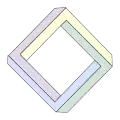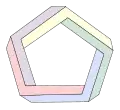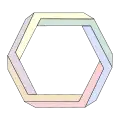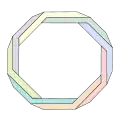Penrose triangle
The Penrose triangle, also known as the Penrose tribar or the impossible tribar,[1] is a triangular impossible object, an optical illusion consisting of an object which can be depicted in a perspective drawing, but cannot exist as a solid object. It was first created by the Swedish artist Oscar Reutersvärd in 1934. Independently from Reutersvärd, the triangle was devised and popularized in the 1950s by psychiatrist Lionel Penrose and his son, prominent Nobel Prize-winning mathematician Sir Roger Penrose, who described it as "impossibility in its purest form".[2] It is featured prominently in the works of artist M. C. Escher, whose earlier depictions of impossible objects partly inspired it.

Description
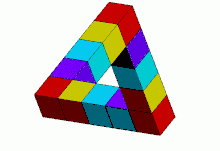
The tribar appears to be a solid object, made of three straight beams of square cross-section which meet pairwise at right angles at the vertices of the triangle they form. The beams may be broken, forming cubes or cuboids.
This combination of properties cannot be realized by any three-dimensional object in ordinary Euclidean space. Such an object can exist in certain Euclidean 3-manifolds.[3] There also exist three-dimensional solid shapes each of which, when viewed from a certain angle, appears the same as the 2-dimensional depiction of the Penrose triangle on this page (such as – for example – the adjacent image depicting a sculpture in Perth, Australia). The term "Penrose triangle" can refer to the 2-dimensional depiction or the impossible object itself.
If a line is traced around the Penrose triangle, a 4-loop Möbius strip is formed.[4]
Depictions
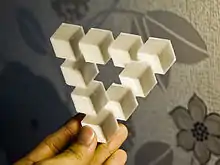
M.C. Escher's lithograph Waterfall (1961) depicts a watercourse that flows in a zigzag along the long sides of two elongated Penrose triangles, so that it ends up two stories higher than it began. The resulting waterfall, forming the short sides of both triangles, drives a water wheel. Escher points out that in order to keep the wheel turning, some water must occasionally be added to compensate for evaporation.
Sculptures
 Impossible triangle sculpture as an optical illusion, East Perth, Western Australia
Impossible triangle sculpture as an optical illusion, East Perth, Western Australia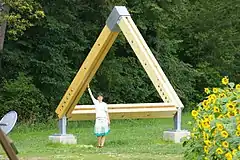 Impossible Triangle sculpture, Gotschuchen, Austria
Impossible Triangle sculpture, Gotschuchen, Austria Real Penrose Triangle, Stainless Steel, by W.A.Stanggaßinger, Wasserburg am Inn, Germany. This type of "Impossible Triangle" was first created in 1969 by the Soviet kinetic artist Vyacheslav Koleichuk. Published in 1972, in the magazine "Technica Molodezhi."[5]
Real Penrose Triangle, Stainless Steel, by W.A.Stanggaßinger, Wasserburg am Inn, Germany. This type of "Impossible Triangle" was first created in 1969 by the Soviet kinetic artist Vyacheslav Koleichuk. Published in 1972, in the magazine "Technica Molodezhi."[5]
Other Penrose polygons
While it is possible to construct analogies to the Penrose triangle with other shapes and regular polygons to create a Penrose polygon, the visual effect is not as striking, and as the number of sides increases, the object seems merely to be warped or twisted.
See also
- Impossible trident
- Shepard elephant
- Three hares
- Penrose steps
- Mobius strip
References
- Pappas, T. "The Impossible Tribar." The Joy of Mathematics. San Carlos, CA: Wide World Publ./Tetra, p. 13, 1989.
- L. S. Penrose, R. Penrose (1958). "IMPOSSIBLE OBJECTS: A SPECIAL TYPE OF VISUAL ILLUSION". The British Journal of Psychology. 49 (1): 31–33. doi:10.1111/j.2044-8295.1958.tb00634.x.CS1 maint: uses authors parameter (link)
- Francis, George (1988). A topological picture book. Springer. ISBN 0-387-96426-6. In the chapter on the Penrose tribar, Francis attributes this observation to John Stillwell.
- Gardner, Martin (1978). Mathematical Games, August 1978 A Möbius band has a finite thickness, and so it is actually a twisted prism. SCIENTIFIC AMERICAN, A DIVISION OF NATURE AMERICA, INC.
- Федоров, Ю. (1972). "Невозможное-Возможно". Техника Молодежи. 4: 20–21.
External links
| Wikimedia Commons has media related to Penrose triangle. |
